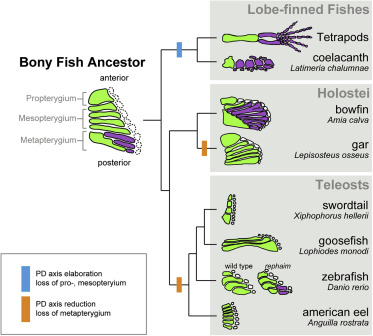Fig. S1
Figure S1. Phylogenetic patterns of pectoral appendage articulation in bony fishes, related to Figure 1
The last common ancestor of the bony fishes (the clade that encompasses the teleost and tetrapod lineages) had a polybasal condition in which the most proximal endochondral elements of the fin articulated with the shoulder girdle. The pectoral fin consisted of the anterior propterygium, the middle mesopterygium, and the posterior metapterygium. In the lineage leading to tetrapods, the propterygium and mesopterygium are postulated to have been lost along with the dermal fin rays, while new long bones that articulate end on end were added along the PD axis of the metapterygium, ultimately forming the limb. Conversely, in the teleost lineage, it is proposed that the metapterygium was lost while the propterygium and mesopterygium were retained, and no teleost exhibits end-on-end articulation of long bones in the pectoral fin. While rare, variation in the teleost pectoral fin endoskeleton is observed in proximal radial length as well as the number of radials along the AP axis of the fin in different clades. However, no teleost species showing PD long bone articulation comparable to that seen in tetrapods have been described.
Reprinted from Cell, 184(4), Hawkins, M.B., Henke, K., Harris, M.P., Latent developmental potential to form limb-like skeletal structures in zebrafish, 899-911.e13, Copyright (2021) with permission from Elsevier. Full text @ Cell

